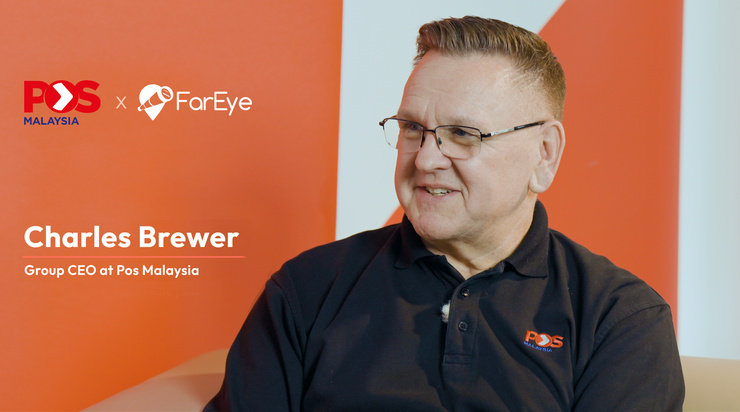- Last-Mile
Leading the Charge: How Automation Software is Setting New Standards in Last Mile Delivery
Table of Contents
- Why Last Mile Automation Software Matters
- The New Standards for Last Mile Delivery
- What is Last Mile Delivery Automation Software?
- How Automation Software Drives Last Mile Excellence
- Business Impact of Last Mile Automation Software
- Key Considerations When Selecting Automation Software
- Why Automation Software is the Way Forward in Last Mile Delivery
- FAQ

Retail checkouts today promise next-day arrival and minute-by-minute tracking, but turning that promise into reality depends on software rather than extra trucks. Reports estimate that the global last-mile delivery software market will reach USD 4.41 billion by 2033, expanding at a CAGR of 7.26%. These figures signal a clear shift that performance now hinges on algorithms that recalculate routes, balance capacity, and push live alerts the moment conditions change.
Complex networks of orders, traffic, and depot stock change constantly, making manual re-planning impractical. Purpose-built last mile automation software systems digest this variability in real time, turning data turbulence into orderly workflows.
Modern platforms absorb orders, GPS pings, and inventory levels, generate a revised plan quickly, and deliver it to driver phones as well as customer apps. Let us examine how this new generation of last mile automation software is reshaping speed, cost control, and sustainability for both retailers and logistics providers.
Why Last Mile Automation Software Matters
Last mile automation software is now essential for any business looking to deliver efficiently and meet growing customer demands. With real-time route adjustments, automated notifications, and data-driven performance insights, businesses can minimize delivery delays, reduce manual errors, and streamline every step from dispatch to doorstep.
However, companies must also address potential issues such as poor data quality, driver adoption challenges, or integration silos that can limit the impact of automation. The right platform should offer user-friendly interfaces, robust data validation, and flexible integration options to overcome these obstacles.
This technology also helps teams handle larger order volumes and adapt to unpredictable changes without sacrificing service quality or operational control. In today’s fast-paced environment, investing in last mile automation software gives companies a practical edge for both cost savings and customer satisfaction.
The New Standards for Last Mile Delivery
Retailers and carriers now treat precise estimated delivery dates and full end‑to‑end tracking as baseline service requirements. Enterprise shipping teams must, therefore, build systems that publish exact ETAs at checkout and maintain continuous visibility from warehouse release to final hand-off. These capabilities have moved from competitive differentiators to operational essentials for any business that ships direct to customers or stores.
Already, there are city policies that charge congestion fees and set tighter emissions standards on commercial vehicles. Combined, these trends have pushed the bar on service expectations in a way that is fundamentally incompatible with systems that rely on manual planning. Solutions must now prepare for autonomous deliveries, smart lockers, and even drone integration, as these innovations become part of modern delivery networks.
- Evolving E-commerce Demands and Customer Expectations
Shoppers now expect narrow delivery windows, real‑time order visibility, and immediate proof of delivery. Sustainability has also become a key factor, with many buyers favoring carbon-neutral or electric-vehicle shipping options.
Free or low‑cost shipping remains an expectation, yet customers increasingly want the flexibility to reroute or reschedule packages on short notice. These combined demands place tight performance and transparency requirements on every last‑mile operation.
- Why Traditional Approaches are No Longer Enough
Printed manifests and separate dispatch boards leave planners guessing. If an accident blocks a bridge, manual tools cannot adapt in real time. A unified layer of last mile delivery automation continuously re-sequences stops, alerts customers, and updates driver ETAs. Companies that retain legacy processes often see costs rise and lower reorder rates while their automated peers maintain speed and transparency.
What is Last Mile Delivery Automation Software?
Last-mile automation software is a cloud-based control layer that synchronizes order data, route planning, vehicle telematics, and customer communications in near real time. It merges workflows that were once isolated, turning every step from warehouse scan to doorstep confirmation into a rules-based, data-driven sequence. As a result, managers, drivers, and customers all share a single, continuously updated view of each shipment's status, even when road or weather conditions change.
- Defining Automation in the Modern Supply Chain
Today, automation in logistics refers to eliminating individual manual steps in favor of a coordinated stream of data flow and decision-making that covers the range of the fulfillment cycle. Last-mile automation software takes orders from the commerce platform, stock levels from the warehouse-management system, and location signals from telematics units.
It then considers real-time vehicle capacity, service priority, and delivery constraints to produce an executable plan for traffic scheduling on-the-fly. Similarly, automation is applied both upstream and downstream. In the warehouse, suggested carton sizes minimize wasted space, and at the doorstep, mobile apps snap photos of signatures that feed directly into customer-service dashboards.
Unifying these previously siloed tasks, last‑mile delivery automation ensures every link in the supply chain draws from one dynamically updating data pool. As a result, processes, from picking to proof of delivery, stay aligned with real-time conditions and maintain consistent performance.
- Key Functionalities and Technology Foundations
Today's last mile automation software consists of a number of interconnected modules that allow raw shipment data to be transformed into predictable, repeatable delivery results. A machine learning-based optimizer considers live traffic, promised time windows, and vehicle constraints to compute optimal tours in just a few minutes. Capacity planning engines subsequently harmonize load volume to available labor to minimize both under-utilized vans as well as overallocated crews. With exception-management workflows, every milestone is monitored, generating alerts and follow-on actions when a delay, address mismatch, or scan failure happens.
The stack is completed by driver mobility tools, which offer turn-by-turn navigation, electronic proof-of-delivery capture, and real-time messaging to keep field teams in lockstep with control tower automation. Open APIs that are well-documented link the platform to order-management systems, warehouse management systems, and carrier billing systems.
This two-way data movement guarantees each decision is based on the right data and results in error-free invoicing and reconciliation. The entire solution is built on an event-streaming architecture that will enable future expansion for curb-space reservations, automated locker hand-offs, or EV dispatch modules with sub-second latency.
Granular role-based security, cloud-native scalability, and a built-in analytics dashboard provide enterprises with the resiliency and transparency required to operate automated last-mile delivery at a regional or global scale.
How Automation Software Drives Last Mile Excellence
Turning data into dependable doorstep results requires more than dashboards. It demands tools that translate analytics into precise field actions. The capabilities outlined below demonstrate why last mile automation software has become a core element of efficient, high-performance delivery fleets.
- Route Optimization and Intelligent Dispatch
Algorithms test multiple route permutations against live road conditions, vehicle constraints, and service-level targets. The resulting plan feeds directly into driver apps, ensuring every stop sequence is both feasible and fuel-efficient. Businesses using last mile automation software report double-digit mileage cuts and a steady rise in on-time percentage, proving that smart routing underpins successful automated last mile deliveries. - Real-Time Tracking and Live Notifications
Telemetry beacons transmit location, battery status, and dwell times every few seconds. Customers receive branded alerts at pickup, on approach, and after hand-off, all powered by the same engine of last mile delivery automation that monitors the fleet. These proactive notices reduce "Where is my order?" calls and boost perceived reliability. - Automated Exception Handling and Proof of Delivery
Thresholds trigger specific actions when delays or address issues occur: reroute a nearby driver, offer a self-serve reschedule link, or notify customer service to intervene. Digital signatures and time-stamped photos sync instantly, creating tamper-proof proof of delivery. This closed-loop keeps automated last mile deliveries compliant and auditable. - Integration with OMS, WMS, and Carrier Systems
Seamless data exchange prevents double entry and ensures that inventory counts, return authorizations, and carrier scans all update in real time. Integrated last mile automation software eliminates siloed spreadsheets, enabling planners to view load status across partners and accelerate cash cycles through faster billing.
Business Impact of Last Mile Automation Software
Investing in last mile automation software yields cost, speed, and experience gains that manual systems cannot match.
- Reducing Costs and Increasing Efficiency
Delivery optimization engines shorten routes and raise stops per hour, while automated workflows cut phone traffic and paperwork. Businesses that implement last-mile automation technology frequently experience cost savings, demonstrating that automatic last-mile delivery solutions pay off through reduced miles and overtime. - Improving Delivery Speed and Accuracy
Predictive ETAs refresh with each data point, pushing on-time rates higher. Delays trigger reroutes automatically, ensuring items still arrive within the quoted window. This reliability confirms the value of end-to-end last mile delivery automation. - Enhancing Customer Experience and NPS
Live maps, flexible scheduling links, and carbon-impact badges transform delivery from a black-box process into a transparent service. Shippers using last mile automation software often record significant increases in Net Promoter Score because recipients feel informed and respected. - Supporting Sustainability and Compliance
Electric vehicle routing, intelligent load consolidation, and idle-time reduction all come from the same automated engine. Detailed carbon dashboards help organizations set, hit, and prove sustainability milestones. In turn, these features make automated last mile deliveries a central pillar of broader ESG strategies.
Key Considerations When Selecting Automation Software
The platform you choose will shape your network's flexibility, data integrity, and long-term cost profile. A structured evaluation helps ensure the solution can evolve alongside changing volumes, service models, and regulatory demands.
- Scalability and Future-Readiness
Verify that the last mile automation software supports micro-services, horizontal scaling, and configuration-driven workflows so automated last mile deliveries remain stable as volumes climb or territories expand.
These attributes enable last mile automation software to scale smoothly during peak seasons and launch new regions without requiring extensive coding. In addition, ensure the roadmap includes autonomous vehicle compatibility and curb-management APIs.
- Data Security and Compliance
Encryption in transit and at rest, along with granular role permissions, protects customer data and meets regional privacy laws. A platform that embeds such safeguards keeps last mile delivery automation running even as regulations tighten.
- Usability, Training, and Change Management
Driver workflow tools need offline functionality and intuitive interfaces, so adoption is quick. Dispatcher dashboards should surface real-time KPIs instead of forcing manual exports. Structured onboarding and in-app guidance reduce resistance and let teams realize value from last mile automation software sooner.
Why Automation Software is the Way Forward in Last Mile Delivery
Last-mile networks will only become denser, faster, and more transparent. Spreadsheets and manual dispatch cannot evolve at the same speed as real-time data flows or rising consumer expectations.
Purpose-built last mile automation software converts traffic feeds, inventory changes, and customer preferences into live, executable routes, enabling fleets to preserve precision even as volumes climb. Adopting such automation is no longer a tactical upgrade; it is the strategic foundation for cost-efficient, compliant, and customer-centric delivery in the years ahead.
FarEye demonstrates how this next generation of tools moves organizations from reactive firefighting to proactive control. Our platform pairs AI-based route optimization with a unified control tower. So that dispatchers can replan within seconds, drivers always have current ETAs, and customers receive dependable, branded updates. To explore how these capabilities can strengthen your network, contact the FarEye team and schedule a tailored demonstration.
FAQ
Can the software integrate with my TMS and OMS?
Yes, FarEye is designed for seamless integration with major Transportation Management Systems (TMS) and Order Management Systems (OMS). The open API architecture allows for quick connectivity, enabling real-time data flow between your logistics operations and core business systems. This integration ensures consistent updates, unified dashboards, and more efficient delivery orchestration.
Does it support offline driver workflows?
Absolutely. FarEye’s driver app is built to support offline workflows, allowing drivers to access route details, record delivery status, and capture proof of delivery even in areas with limited or no network connectivity. All information automatically syncs with the system once the connection is restored, ensuring operational continuity and reliable data capture.
Sources:
https://www.businessresearchinsights.com/market-reports/last-mile-delivery-software-market-110254

Komal Puri is a seasoned professional in the logistics and supply chain industry. As the AVP of Marketing and a subject matter expert at FarEye, she has been instrumental in shaping the industry narrative for the past decade. Her expertise and insights have earned her numerous awards and recognition. Komal’s writings reflect her deep understanding of the industry, offering valuable insights and thought leadership.
Let's Talk to Our Experts and Optimize Your Deliveries Today!
An expert from our team will reach out within 24 hours


